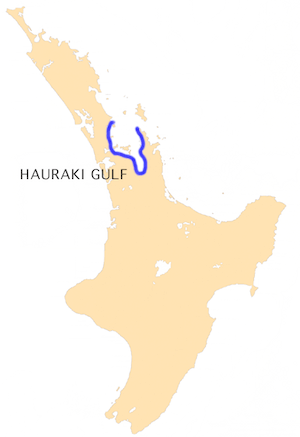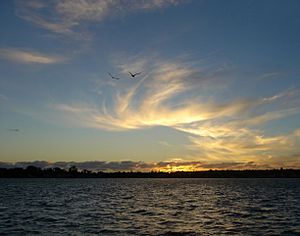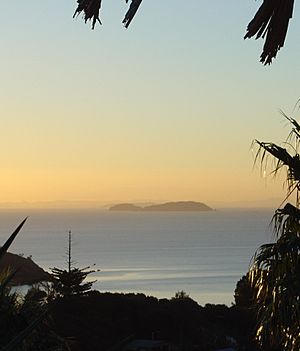Hauraki Gulf facts for kids
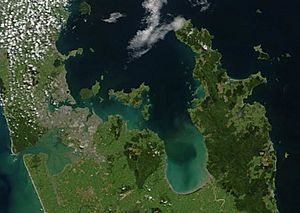
The Hauraki Gulf / Tīkapa Moana is a large bay on the North Island of New Zealand. It covers about 4,000 square kilometers (about 1,500 square miles). This important area sits between the Auckland Region, the Hauraki Plains, the Coromandel Peninsula, and Great Barrier Island. Most of the gulf is part of the Hauraki Gulf Marine Park, which helps protect its amazing nature.
The name "Hauraki" comes from the Māori language and means north wind. In 2014, the gulf was officially given its dual name: Hauraki Gulf / Tīkapa Moana. The New Zealand Ministry for Culture and Heritage says that "Tīkapa Moana" can be translated as "the mournful sea."
Contents
Exploring the Hauraki Gulf's Geography
The Gulf's Shape and Location
The Hauraki Gulf is a part of the huge Pacific Ocean. It connects to the Pacific in the north and east. Large islands like Great Barrier Island and Little Barrier Island protect the gulf from the strong Pacific waves. The long Coromandel Peninsula, which is about 80 kilometers (50 miles) long, also helps protect the gulf from the east. This means the gulf is mostly safe from strong winds, except for those coming from the north.
Three big channels connect the gulf to the Pacific Ocean. The Colville Channel is between the Coromandel Peninsula and Great Barrier Island. The Cradock Channel lies between Great Barrier and Little Barrier islands. The Jellicoe Channel is found between Little Barrier Island and the Northland Peninsula. North of Auckland, several pieces of land stick out into the gulf. One of these is the Whangaparaoa Peninsula. Tiritiri Matangi Island is located near the end of this peninsula. Further north, Kawau Island sits close to the Tāwharanui Peninsula.
Many beautiful beaches can be found along the shores of the gulf. These beaches are popular spots for swimming and surfing. Thousands of years ago, during the last ice age, the sea level was much lower. The Hauraki Gulf area was actually dry land then! The sea rose to its current level about 7,200 years ago, covering the land and forming the gulf we see today.
Islands of the Gulf
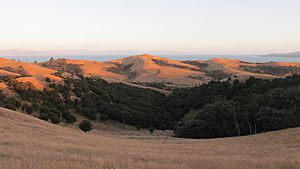
In the western part of the gulf, a line of islands protects the entrance to the Waitematā Harbour, which is one of Auckland's two harbors. These islands include Ponui Island, Waiheke Island, Tiritiri Matangi Island, and the famous Rangitoto Island. Rangitoto is a dormant (sleeping) volcano with a distinctive dome shape. It is connected to the much older Motutapu Island by a causeway, which is like a raised road over water. These islands are separated from the mainland by the Tamaki Strait and Rangitoto Channel.
Other islands in the Hauraki Gulf include:
- Motukorea (also known as Browns Island)
- Motuihe Island
- Pakihi Island
- Pakatoa Island
- Rakino Island
- Rotoroa Island
These islands are located closer to Waiheke and Rangitoto. Further east, you'll find Tarahiki Island. Near the Coromandel Peninsula are the Motukawao Islands and Whanganui Island. In the outer part of the gulf, there is also Channel Island.
The Firth of Thames
At the very southern end of the Hauraki Gulf is a wide, shallow area called the Firth of Thames. Beyond this area are the Hauraki Plains, which are flat lands drained by two rivers, the Waihou River and the Piako River. The Hunua Ranges and the hills of the Coromandel Peninsula rise up on both sides of the Firth of Thames.
Wildlife and Environment in the Hauraki Gulf
Amazing Animal Species

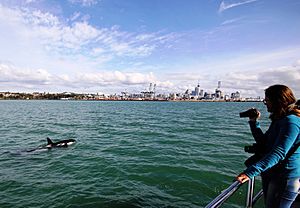
The Hauraki Gulf is home to many incredible animals. You can often spot bottlenose dolphins and common dolphins. Sometimes, common dolphins gather in huge groups called "super schools," with 300 to 500 animals or even more! Various types of whales and orcas are also seen quite often. In fact, about 25 different kinds of marine mammals live in or visit the gulf. Nearly a third of all the world's marine mammal species can be found here!
Among the larger whales, Bryde's whales live in the gulf all year round. Sadly, because these waters are busy with boats, many Bryde's whales are hit by ships. This sometimes leads to several whales dying each year. There are an estimated 100 to 200 Bryde's whales left in the area. In recent years, more baleen whales have been seen migrating through the gulf. These include humpback whales, southern blue whales, pygmy blue whales, and southern minke whales. Less often, fin whales and sei whales are also spotted. Sperm whales visit the gulf from time to time.
Many of the islands in the gulf are special places for birds. They are official or unofficial bird sanctuaries, protecting rare or endangered species like kiwi, takahe, brown teal, and grey-faced petrel. On islands like Tiritiri Matangi Island and Little Barrier Island, many bird species that had disappeared from the area have been brought back. Some birds have even returned on their own after pests (like rats) were removed from their breeding grounds.
Challenges to the Environment
The Hauraki Gulf is a beautiful natural place, but it has faced a lot of harm from human activities over the last century. A big study in 2011 showed that the environment was still getting worse or staying at problematic levels. However, volunteer groups have worked hard to clean up the coast, collecting about 450,000 liters of trash from the shore. More efforts are still needed to keep the gulf healthy.
One major problem has been industrial fishing. For example, snapper fishing reached its peak in the 1970s, with over 10,000 tonnes caught each year. Even today, private fishing of snapper is a big factor, with 400 to 800 tonnes caught annually. This heavy overfishing has harmed the ocean environment by removing a main predator from the food chain. This has led to other problems, like the disappearance of kelp beds, which are important underwater forests. Instead, areas are now covered by kina (sea urchins). Trawler fishing, which drags nets along the seafloor, is also very damaging. Lobster numbers are also not recovering well. Experts believe that today's fish stocks are only about 25% of what they were before Europeans arrived.
Another big problem is the pollution from nitrogen that flows into the gulf from nearby farms. Almost 90% of this pollution comes from dairy farms around the Firth of Thames.
Other activities, like dredging for mussel beds in the Firth of Thames, have also caused damage. In 1961, about 15 million mussels were taken, and soon after, the industry collapsed. Even after 40 years, the mussel beds have not recovered. This is likely because the dredging destroyed the seafloor, and mud from farming in the Firth of Thames also makes it hard for mussels to grow.
While many beaches are great for swimming and surfing, some near cities have pollution problems. About 14 out of 52 beaches in the Auckland Region sometimes have unsafe pollution levels, mostly from untreated sewage. However, environmental groups are working hard to clean these beaches and bring them back to life.
The Hauraki Gulf Marine Park
Why the Park Was Created
The Hauraki Gulf Marine Park was created by a special law called the Hauraki Gulf Marine Park Act 2000. This law recognized how important the Hauraki Gulf is to New Zealand.
The law states that the connection between the Hauraki Gulf, its islands, and the land around it is very important for keeping the environment healthy. This healthy environment helps:
- Support the historic, traditional, cultural, and spiritual connection of tangata whenua (Māori people) with the gulf and its islands.
- Provide for the social, economic, recreational, and cultural well-being of people and communities.
- Allow people and communities to use the gulf's resources for economic activities and fun.
- Keep the soil, air, water, and ecosystems of the gulf healthy.
The main goals for managing the Hauraki Gulf, its islands, and the surrounding land are to:
- Protect and improve the environment's ability to support life.
- Protect and improve the natural, historic, and physical resources of the gulf.
- Protect and improve resources (like seafood) that tangata whenua have a special connection with.
- Protect the cultural and historic links that people have with the gulf's resources.
- Keep and improve how the gulf's resources help the social and economic well-being of people in the gulf and New Zealand.
- Keep and improve the resources that make the Hauraki Gulf a great place for recreation and enjoyment for everyone.
The Park's Special Importance
The Hauraki Gulf Marine Park is different from other protected areas in New Zealand. It's not just a marine (ocean) environment, but it's also home to over a million people living along its shores and on its islands. It also has many wildlife sanctuaries (protected areas for animals) on its islands, which are unique in New Zealand.
See also
 In Spanish: Golfo de Hauraki para niños
In Spanish: Golfo de Hauraki para niños


